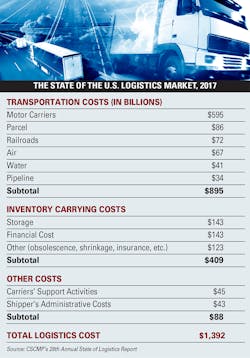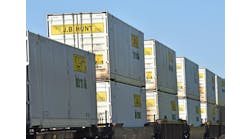Given the swiftly changing logistics environment, those who navigate the new world we live in need a roadmap to guide their actions. The Council of Supply Chain Management Professionals' annual State of Logistics report attempts to offer just such a map -- accompanied by some timely warnings.
The research, done by A.T. Kearney and sponsored by Penske Logistics for CSCMP, vividly depicts a supply chain struggling under the twin demands of constrained capacity and the need for significant technological investment to help service providers and their customers keep up with soaring growth.
The high demand for logistics services took some by surprise, including the researchers. "The demand-supply balance shifted much more dramatically this year when compared to last year," says Sean Monahan of A.T. Kearney and co-author of the report.
"In 2015 it was a dark story if you were a carrier. There was a lot of excess capacity in the marketplace. We saw that starting to turn around in 2016 and continued to accelerate into 2017," he notes. "Many shippers had been lulled into a very soft market, costs were coming down and it was a beneficial fuel market. That's when things started to go crazy. I think many organizations were caught a bit flat-footed."
Overall, total spending on logistics rose to a record of nearly $1.5 trillion in 2017, up 6.2% from the year before, and about $250 billion more than companies spent on logistics in 2008. Rising interest rates, the higher price of fuel and impending tariffs on imports are expected to add to costs over the next year, the report's authors say.
Statistics depict an industry straining to fulfill its mission in the face of a booming e-commerce sector and unprecedented demand for services, particularly in the trucking and courier industries. Last year saw a 7% rise in overall trucking costs, including a 9.5% rise in private and dedicated trucking costs, 6.4% in the for-hire truckload and 6.6% in less-than-truckload (LTL) segments.
This year has seen even more rate increases, with the prospect of more on the horizon, the researchers warn. "Barring a sharp, sudden economic downturn, carriers will hold the upper hand for at least the next few years. Carriers are in control as demand outstrips supply, while shippers try to 'create capacity' by improving efficiency whenever possible."
Ports and railroads are straining in part because of Washington's failure to adopt an infrastructure program. Rail intermodal, a natural alternative to trucking, is seeing strong increases in traffic. But some Class 1 railroads, CSX in particular, are cutting back on intermodal service to favor more profitable freight.
Management of the other railroads are looking over their shoulders at CSX, which has delighted Wall Street by lowering its operating ratio at the expense of service cutbacks, closed rail yards and the shedding of thousands of employees. Concerns have been raised about possible widespread rail service failures this fall much like we saw in 2013-14.
Couriers Under Threat
Couriers also are straining under the challenge of e-commerce deliveries. While companies led by Amazon experiment with a variety of last-mile delivery concepts, none has turned out to be the magic bullet.
Parcel delivery volumes jumped 7% to $99 billion in 2017. Shippers saw major rate increases and adjustments in surcharges from the U.S. Postal Service, UPS and FedEx. But many people are not aware that last-mile deliveries are also handled by thousands of small local and regional package delivery firms.
Attendees at the Customized Logistics and Delivery Association (CLDA) annual meeting said the industry struggles to meet skyrocketing demand, especially in the face of the frontal assault on independent contractors, which adds to costs.
States and cities like Seattle are severely restricting use of driver contractors in port drayage and car services like Uber and Grubhub. Package delivery companies are prime targets as well.
A recent California Supreme Court decision holding that independent contractors cannot be in the same business as those who use them is expected to wipe out the use of independent contractor drivers in the courier and trucking industries. These regulatory actions are only exacerbating the shortage of independent drivers.
Ever since the issue of a driver shortage was raised in the 1980s, some in the logistics industry thought the trucking industry was crying wolf. However, the reality cannot be denied now and the situation has become downright desperate.
The CSCMP researchers believe this is a short-term issue that will be solved by higher driver pay and the advent of technological innovations like driverless trucks. Other observers are not so sanguine.
A technological innovation that reduced driver productivity is the electronic logging device (ELD), mandated by the federal government for all over-the-road trucks at the end of last year. That slashed trucking productivity by as much as 4.5%, according to some estimates. However, members of the shippers and providers panel at the CSCMP press conference stressed that the tradeoff is a welcome improvement to safety now that drivers cannot cheat on their logbooks.
The shortage gained the attention of the mainstream news media. A recent article in The Washington Post led off with an anecdote about an 87-year-old man who was looking for work and was told by a trucking company that if he had a commercial drivers license, they would put him in a cab that day.
Earlier this year it was revealed that the trucking industry was short 51,000 drivers. Estimating there are about a half-million truck drivers in the United States, Bob Costello, American Trucking Associations chief economist observed, "When you're short 51,000 on a base of 500,000, that's a lot."
Since then ATA revised its estimates, projecting the driver shortage will rise to 63,000 by the end of this year. "If things don't change, and we continue up this progression, by 2026, we will be at 170,000 drivers short. If we get there, not only is our industry in a world of hurt, our economy is in a world of hurt," Costello says.
Part of the problem is that younger people are avoiding the profession and the reasons are legion, but the main factor is the low esteem in which they -- and it seems most people -- hold professional truck drivers. It's hard to conceive of another skilled profession as poorly regarded as truck driving.
ATA has an ongoing program to recruit military veterans with heavy-duty driving experience. One problem is that 21 is the legal age limit for driving a truck in interstate commerce (preferably 25, according to insurers). The Trump Administration, acting on an ATA request, will conduct a pilot program allowing veterans under 21 to obtain driving jobs.
Innovation and experimentation in regard to driverless trucks are continuing. When they will be in regular use is anyone's guess, but public acceptance of the technology appears to be lagging in the wake of high-profile accidents -- some fatal -- involving driverless cars.
Seeking Tech Solutions
If we can't mint enough new truck drivers, we have to look for efficiencies, exploiting technology and collaborating more closely than ever before -- and that is exactly what third-party logistics (3PL) service providers and their customers are doing.
In addition to fully autonomous trucks, innovations include Uberization of freight, blockchain, artificial intelligence applications, truck platooning, electric vehicles, autonomous mobile robots, and drones and unmanned aerial vehicle delivery systems, according to the CSCMP report.
Warehousing is one link in the supply chain that needs to take a more active role in embracing technological innovation, according to the researchers. Whether the cause is e-commerce growth, the tight labor market, or changing distribution models, inventories and carrying costs are rising.
To move goods closer to end customers, companies are adding safety stocks, expanding overflow capacity and increasing inventories. "These measures further reduce warehouse capacity, driving rates even higher," the report says. "Companies that recognize and capitalize on this trend will succeed, with smart technology investments and astute strategic choices separating winners from losers."
An example of the impact technology can have was cited by a CLDA speaker from a major CPG manufacturer (unidentified because of restrictions imposed by conference organizers). He described his firm's experiment with almost totally automating a standard shelf-and-aisle warehouse, including use of robots and driverless forklifts. Previously, taking inventory in that facility took two weeks; using drones, that shrunk to two hours.
The need for automation is undeniable. A 2014 study by The Manufacturing Institute and Deloitte projected that employment in manufacturing and warehousing would fall a 2 to 3.5 million workers short of needs by 2025 -- an estimate issued three years before the current economic surge.
Undergoing profound change are transportation management systems (TMS) and warehouse management systems (WMS), which hold the promise of improved management and planning of carrier capacity and inventories. At the CLDA conference a panel of TMS software providers and customers said moving away from home-brew proprietary systems to off-the-shelf systems makes sense today. The challenge for carriers and shippers is to get the various systems to talk to each other.
TMS users and providers also are working together to do that. According to one software executive, a major stumbling block is the extraordinary growth of data systems is expected to process. Perhaps AI will provide the solution to the challenges posed by Big Data in the future, but business continues to struggle with it now.
Science Fiction Becomes Real
Another potential solution to managing data and generating supply chain solutions is quantum computing, which promises blindingly-fast speeds for handling enormous amounts of data and is already seeing its first applications.
"This will become increasingly important to unlocking the value of data, as the tens of billions of devices in the Internet of Things, for example, drive the volume of available data into the stratosphere," says the Boston Consulting Group. Although full potential may not be reached for another 10 to 20 years, keep in mind that blockchain had been around for 20 years before its recent applications.
Collaboration between providers and customers can squeeze out costs in other areas as well. Shippers said freight damages were a major challenge in 2016 but in 2017 damages declined by 10%, according to a survey conducted by Averitt Express. On-time service issues dropped by more than 4%, and billing and customer service also improved.
"These improvements could be attributed to a variety of factors," Averitt said. "Technology enhancements may have played a role in some regards, but communication more often than not is the cause of a better relation between carriers and shippers. Whether it's moving freight domestically or abroad, shippers and service providers will need to work together to find mutual success."
A perfect example of how technology and collaboration can work to reduce costs was highlighted by one speaker during the shipper-3PL panel at the CSCMP press conference announcing the report. Cheryl Capps, vice president of global supply chain for Corning International, noted than whenshe ships a load of plate glass it is handled by no fewer than eight parties.
In the past when a load was damaged, "I knew it was none of those eight because each of them said they didn't do it." Corning then started attaching tiny devices to the sheets that recorded when and where damage occurred. Capps said the service providers like the new system because it allows them to work with Corning to find solutions instead of wasting time on finger-pointing.
The increasing demands of the supply chain will drive further consolidation in the industry, the CSCMP researchers predict. But smaller players like 3PL warehouses can survive if they are willing to invest in relatively inexpensive technology. "The proliferation of choices at various price points means warehouse operators will find technologies suited to their needs and budgets," they point out.
The immediate tax benefits and bonus depreciation on equipment are powerful incentives in the short term. The tax reform law's five-year window for writing off the cost of new equipment and buildings should help fuel investment in these solutions.
The only conclusion we can reach is that embracing technological innovation and collaboration is the only way to control logistics costs in the future.





